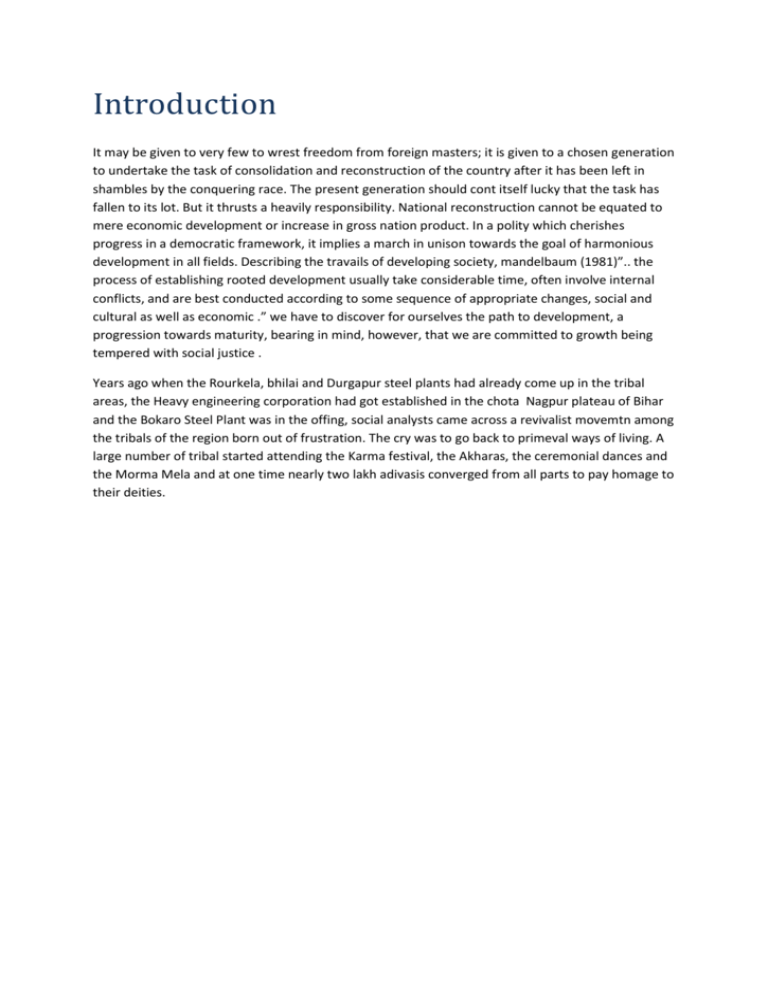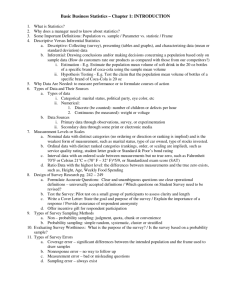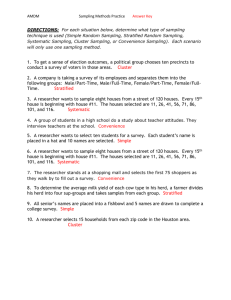alok@research
advertisement

Introduction It may be given to very few to wrest freedom from foreign masters; it is given to a chosen generation to undertake the task of consolidation and reconstruction of the country after it has been left in shambles by the conquering race. The present generation should cont itself lucky that the task has fallen to its lot. But it thrusts a heavily responsibility. National reconstruction cannot be equated to mere economic development or increase in gross nation product. In a polity which cherishes progress in a democratic framework, it implies a march in unison towards the goal of harmonious development in all fields. Describing the travails of developing society, mandelbaum (1981)”.. the process of establishing rooted development usually take considerable time, often involve internal conflicts, and are best conducted according to some sequence of appropriate changes, social and cultural as well as economic .” we have to discover for ourselves the path to development, a progression towards maturity, bearing in mind, however, that we are committed to growth being tempered with social justice . Years ago when the Rourkela, bhilai and Durgapur steel plants had already come up in the tribal areas, the Heavy engineering corporation had got established in the chota Nagpur plateau of Bihar and the Bokaro Steel Plant was in the offing, social analysts came across a revivalist movemtn among the tribals of the region born out of frustration. The cry was to go back to primeval ways of living. A large number of tribal started attending the Karma festival, the Akharas, the ceremonial dances and the Morma Mela and at one time nearly two lakh adivasis converged from all parts to pay homage to their deities. RESEARCH Meaning of research : The word research .this words is made up by adding re as a prefix to the word search .search isto make known of an existent unknown things. Therefore research means to elicit some fact out of known things. Research is an existential as well as powerful tools leading towards progress. The curious nature of man prompts him to uncover the mystery of nature. He tried his best to make those mysteries into notice. He establishes some truths of these by applying his cause and effect method .we can summarize the modern meaning of research in following points: An attitude of inquiary An attempt to elicit facts A systematic and scholarly application of the scientific method Objective of research The Purpose of research is to discover answer to question through the application of scientific procedure. The main aim of research is to find out the truth which is hidden and which has not been discovered as yet. Though each research study has its own specific purpose. We may think of research objectives as falling into a number of following broad grouping: 1. To gain familiarity with a phenomenon or to achieve new insight into it (studies with this object in view are termed as exploratory or formulate research studies) 2. To portray accurately the characteristics of a particular individual, situation or a group (studies with this object in view are known as descriptive research studies) 3. To determine the frequency with which something occurs or with which it is associated with something else (studies with this object in view are known as diagnostic research studies) 4. To test a hypothesis of a causal relationship between variables(such studies are known as hypothesis-testing research studies) Types of research The basic types of research are as follows: 1. Descriptive vs analytical: Descriptive research include surveys and fact-finding enquiries of different kinds. The major purpose of descriptive research is description of the state of affairs as it exists at present. In social science and business research we quite often use the term ex post facto research for descriptive research studies. The main characteristics of this method is that the researcher has no control over the variables; he can only report what has happened or what is happening. Most ex post facto research projects are used for descriptive studies in which the researcher seeks to measure such items as, for example frequency of shopping, preferences of people, or similar data. Ex post facto studies also include attempts by researchers to discover causes even when they cannot control the variables. The methods of research utilized in descriptive research are survey methods of all kinds, including comparative and co-relational methods. In analytical research, on the other hand, the researcher has to use facts or information already available, and analyze these to make a critical evaluation of the material. 2. Applied vs fundamental: research can either be applied (or action) research or fundamental (to basic or pure) research. Applied research aims at finding a solution for an immediate problem facing a society or an industrial/business organisation, whereas fundamental research is mainly concerned with generalisation and with the formulation of a theory. “Gathering knowledge for knowledge’s sake is termed “pure” or “basic” research.” Research concerning some natural phenomenon or relating to pure mathematics are examples of fundamental research, but research aimed at certain conclusions (say, a solution) facing a concrete social or business problem is an example of applied research. 3. Quantitative vs qualitative : Quantitative research is based on the measurement of quantity or amount. It is applicable to phenomena that can be expressed in terms of quantity. Qualitative research, on the other hand, is conceded with qualitative phenomenon, ie investigating the reasons for human behaviour. We quite often talk of ‘motivation research’, an important type of qualitative research. This type of research aims at discovering the underlying motives and desires, using in depth interviews for the purpose. Other techniques of such research are word association test, sentence completion test, story completion test and similar other projective techniques. Attitude or opinion research ie. Research designed to find out how people feel or what they think about a particular subject or institution is also qualitative research. Qualitative research is specially important in the behavioural science where the aim is to discover the underlying motivate people to behave in a particular manner or which make people like or dislike a particular thing. It may be staffed, however, that to apply qualitative research in practice is relatively a difficult job and therefore, while doing such research, one should seek guidance from experimental psychologists 4. Conceptual vs empirical: conceptual research is that related to some abstract ideas or theory. It is generally used by philosophers and thinkers to develop new concepts or to reinterpret existing ones. On the other hand, empirical research relies on experience or observation alone, often without due regard for system and theory. It is data based research, coming up with conclusions which are capable of being verified by observation or experiment. We can also call it as experimental type of research. In such a research it is necessary to get at facts firsthand, at their source, and actively to go about doing certain things to stimulate the production of desired information. in such a research, the researcher must first provide himself with a working hypothesis or guess as to the probable result. He then sets up experimental design with he thinks will manipulate the persons or the materials conceded so as to bring forth the desired information. Such research is thus characterised by the experimenters’ control over the variables under study and his deliberate manipulation of one of them to study its effects. Empirical research is appropriate when proof is sought that certain variables affect other variables in some way. Evidence gathered thorugh experiments or empirical studies is today considered to be the most powerful support possible for a given hypothesis. Research methods versus methodology It seems appropriate at this juncture to explain the difference between research methods and research methodology. Research methods may be understood as all those methods/techniques that are used for conduction of research. Research methods or techniques. Thus refer to the methods the researchers use in performing research operations. In other words, all methods which are used by the researcher during the course of studying his research problem are termed as research methods. Since the object of research, particularly the applied research, it to arrive at a solution for a given problem, the available data and the unknown aspects of the problem have to be relate to each other to make a solution possible. Research methodology is a way to systematically solve the research problem. It may be understood as a science of studying how research is done scientifically. In it we study the various steps that are generally adopted by a researcher in studying his research problem along with the logic behind them. It is necessary for the research to know not only the research method/techniques but also the methodology. Researchers not only need to know how to develop certain indices or tests, how to calculate the mean, the mode, the median or the standard deviation or chi-square, how to apply particular research techniques, but they also need to know which of these methods or techniques, are relevant and which are not, and what would they mean and indicate and why. Researchers also need to understand the assumption underlying various techniques and they need to know the criteria by which they can decide that certain technique and procedures will be applicable to certain problems and others will not. All this means that it is necessary for the researcher to design his methodology for his problem as the same way differ from problem to problem. For example, an architect, who design a building, has to consciously evaluate the basis of his decision, ie. He has to evaluate why and on what basis he select particular size, number and location of doors, windows and ventilators, the researcher decisions to evaluation before the are implemented. He has to specify very clearly and precisely what decision select and why he select them so that they can be evaluated by others also. Preparing the research design The research problem having been formulated in clear cut terms, the researcher will be required to prepare a research design. ie he will have to state the conceptual structure within which research would be conducted. The preparation of such a design facilitates research to be as efficient as possible yielding maximal information. In other words, the function of research design is to provide for the collection of relevant evidence with minimal expenditure of effort, time and money. But how all these can be achieved depends maily on the research purpose,. Research purpose may be grouped intyo four categories, viz (i) exploration, (ii) description, (iii) diagnosis, and (iv) experimentation. A flexible research design which provides opportunity for considering many different aspects of a problem is considered appropriate if the purpose of the research study is that of exploration. But when the purpose happens to be an accurate description of a situation or of an association between variables, the suitable design will be one that minimises bias and maximises the reliability of the data collected and analysed. There are several research designs, such as, experimental and non-experimental hypothesis testing. Experimental design can be either informal designs (such as before-and-after without control, after-only with control, before-and-after control) of formal designs (such as completely randomized design, randomized block design, Latin square design, simple and complex factorial design), out of which the researcher must select one for his own project. The preparation of the research design, appropriate for a particular research problem, involves usually the consideration of the following: I. II. III. IV. V. The means of obtaining the information. The availability and skills of the researacher and his staff Ixplanation of the way in which selected means of obtaining information will be organised and the ressoning leading to the selection The time available for research and The cost facto relating to the research ie. The finance available for the purpose. Determining sample design All the items under consideration in any field of inquiry constitute a a ‘universe’ or ‘population.’ A complete enumeration of all the items in the ‘population’ is known as a census inquiry. It can be presumed that in such an inquiry when all the items are covered no element of chance is left and highest accuracy is obtained. But in practice this may not be true. Even the slightest element of bias in such an inquiry will get larger and larger as the number of observations increases. Moreover, there is no way of checking the element of bias or its extent except through a resurvey or use of sample checks, besides, this type of inquiry involves a great deal of time, money and energy. Not only this, census inquiry is not possible in practice under many circumstances. For instance, blood testing is done only on sample basis. Hence, quite ofter we select only a few items from the universe for our study purpose. The items so selected constitute what is technically called a sample. The researcher must decide the way of selecting a sample or what is popularly known as the sample design. In other words, a sample design is a definite plan determined before any data are actually collected for obtaining a sample from a given population. Thus, the plan to select 12 of a city’s 200 drugstores in a certain way constitutes a sample design. Samples can be either probability samples or non-probability samples. With probability samples each element has a known probability of being included in the sample but the non-probability samples do not allow the researcher to determine this probability. Probability samples are those based on simple random sampling, systematic sampling, stratified sampling, cluster/area sampling whereas non-probability samples are those based on convenience sampling, judgement sampling and quota sampling techniques, a brief mention of the important sample designs is as follows: I. Deliberate sampling: deliberate sampling is also known as purposive or non-probability sampling. This sampling method involves purposive or deliberate selection of particular units of the universe for constituent a sample which represents the universe. When population elements are selected for inclusion in the sample based on the ease of access, it can be called convenience sampling. If a researcher wishes to secure data from, say, gasoline buyers, he may select a fixed number of petrol stations and may conduct interviews at these stations. This would be an example of convenience sample of gasoline buyers. II. Simple random sampling This type of sampling is also known as chance sampling or probability sampling where each and every item in the population has an equal chance of inclusion in the sample and each one of the possible samples, in case of finite universe, has the same probability of being selected. III. Systematic sampling In some instances the most practical way of sampling is to select every 15th name on a list, every 10th house on one side of a street and so on. Sampling of this type is known as systematic sampling. An element of randomness is usually introduced into this kind of sampling by using random numbers to pick up the unit with which to start. IV. Stratified sampling If the population from which a sample is to be drawn does not constitute a homogeneous group, then stratified sampling technique is applied so as to obtain a representative sample. In this technique, the population is stratified into a number of non-overlapping subpopulations or strata and sample items are selected from each stratum. If the items selected from each stratum is based on simple random sampling the entire procedure, first stratification and then simple random sampling, is known as stratified random sampling. V. VI. Quota sampling Cluster sampling and area sampling VII. Multi-stage sampling VIII. Sequential sampling









